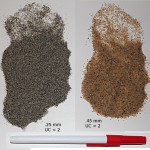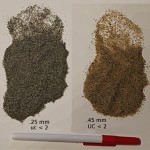Feb. 28 6:30 AM PST: The output water directly from the filter is now perfectly clear based on visual inspection. The filter did not freeze last night, although the temperature was 30 degrees F.
Feb. 27 5 PM PST : The water directly from the filter output is now “clear” like it was before the cold weather set in and froze the filter. From this perhaps we can conclude that the freezing weather caused the filter to produce more turbid water temporarily?
As of Feb. 26, the output water was running clear. Now, as of Feb 27 AM, the outside temperature has dropped to 26 degrees. The filter is frozen, and there is no output.
As of Feb. 25 there has been more improvement, but very slight. I almost cannot see any cloudiness in the water at this point in time. The uv filter would probably work now, but not at 100 percent efficiency. Check the link below for an explanation of how a uv filter works. This is a good learning example. These filters will be effected by freezing weather and changes in water input turbidity. On the positive side note that the output could still be free of coliform even though it is cloudy, but we do not know for sure until the water is tested. Also know that even if the water “looks” perfectly clear, it still may be contaminated with harmful microbes, or toxic heavy metals such as mercury, or lead.
To keep out contamination, the system must be sealed, tested regularly, and the roof must not contain any non-biological contaminants; such as lead, copper, mercury, zinc or asbestos. All these are chemicals that can be found in toxic amounts in runoff from roofing material and / or gutters in a worst-case scenario.
As Feb. 24 2012 there is a very slight improvement – not enough, yet – but it does “look” better. Perhaps the carbon filter has helped. . . ?
Feb. 22, 2012: Filter 4 is putting out cloudy water. (If you can “see” cloudyness in water, it won’t allow a uv filter to work.) Specifically, the turbidity of the output has increased substantially – last week the water “looked” perfectly clear based on a visual observation – now the water “looks” slightly cloudy. I do not know why for sure, but my best guess is that the effective grain size of the coarse sand is too large – .45 mm is likely just too large – but that is just a guess. This has happened before, to a much lesser degree, on all the filters I have put together – after freezing weather. Another possible explanation for the increase in turbidity is that the outside temperature has increased substantially immediately after the freezing temperatures, and there has been a substantial amount of rainfall in the past 3 days. I have added a carbon granule filter, but so far it has not made much difference. I’ll update as soon as there is new information.
If I were using a UV filter to assure absolute purification, the high turbidity would prevent ultra-violet light from adequately sterilizing the water. (the preceding link will open a new page, on that page click on the “GET A COPY” link at the top of the dialogue window) A turbidity level of 5ntu is the maximum level at which a uv light will work – any cloudier and the uv system will fail. Five (5) ntu is just barely visible to the average person. The water may still “look” clear.
The water is not clear enough for a uv filter to operate at 100 percent efficiency (because I can “see” the cloudiness in the water – and that is too much – remember err on the side of caution) , and there would be a very real possibility of contamination in the output following the uv filter. A week ago, the water was very clear; and a uv filter would have worked. This is why it is extremely important to note that a DIY slow sand filter is not foolproof; and furthermore, THERE ARE NO GUARANTEES THAT a filter built exactly like this one will work all the time. Again, I must state that I DO NOT RECOMMEND using water from any filter described on any of my websites for drinking water. The owner/operator of any slow sand filter is TOTALLY responsible for the water quality, and type of use, irregardless of what they read or hear from me; and contamination can come from anywhere at any time.



